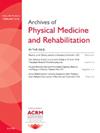History of Childhood Traumatic Brain Injury and Potential Risk Factors for Future Incarceration 8268
IF 3.6
2区 医学
Q1 REHABILITATION
Archives of physical medicine and rehabilitation
Pub Date : 2025-04-01
DOI:10.1016/j.apmr.2025.01.031
引用次数: 0
Abstract
Objectives
Research shows that children who are currently involved in the juvenile justice system have a higher likelihood of reporting a lifetime history of traumatic brain injury (TBI) than children who are not incarcerated. This presentation describes the association between childhood TBI history and select risk factors known to contribute to the likelihood of future incarceration.
Design
Data for this presentation come from the 2020-2021 National Health Interview Survey, a population-based national dataset based on an annual cross-sectional household survey. TBI symptoms, overall health, indicators of school functioning, and behavioral health issues were examined to describe lifetime TBI history, prevalence of developmental disabilities, functional limitations, and school-related services. Additionally, lifetime prevalence of TBI history was calculated and stratified by adverse childhood experiences (ACEs) to compare across subgroups.
Setting
Data for this presentation come from the 2020-2021 National Health Interview Survey, a population-based national data set based on an annual cross-sectional household survey. TBI symptoms, overall health, indicators of school functioning, and behavioral health issues were examined to describe lifetime TBI history, prevalence of developmental disabilities, functional limitations, and school-related services. Additionally, lifetime prevalence of TBI history was calculated and stratified by ACEs to compare across subgroups.
Participants
Participants are parents who have completed the National Health Interview Survey during 2020-2021 (N=10,277).
Interventions
Recommendations for interventions are to better monitor children who experience a TBI to their ensure health and well-being.
Main Outcome Measures
Behavioral health, social, academic, and ACES are the primary outcome measures.
Results
Approximately 8% of (n=10,277) children ages 5-17 years had a lifetime history of TBI according to parent reports. Children with a TBI history were twice as likely to have behavioral health issues, social and academic difficulties, and to have experienced ACEs compared with peers with no history of TBI, effects that align with risk factors identified for entering the justice system.
Conclusions
Youth with a history of TBI may experience health, behavioral, and social changes, many of which have been shown to be associated with risk of entering the justice system. Preventing and promoting better identification and management of TBI during childhood is critical. Such strategies, in addition to postinjury support and rehabilitation, may aid in disrupting the association between TBI and behavioral health difficulties experienced by many children. Preventing TBI in children and managing TBI effects may help youth avoid adverse outcomes and ensure health and wellness for children.
Disclosures
none.
儿童创伤性脑损伤史及未来监禁的潜在危险因素8268
目的研究表明,目前在少年司法系统的儿童比没有被监禁的儿童更有可能报告终身创伤性脑损伤(TBI)史。本报告描述了儿童创伤性脑损伤史与已知的可能导致未来监禁的风险因素之间的关系。本报告的设计数据来自2020-2021年全国健康访谈调查,这是一个基于年度横断面家庭调查的基于人口的国家数据集。研究人员检查了TBI症状、整体健康状况、学校功能指标和行为健康问题,以描述终身TBI病史、发育障碍的患病率、功能限制和学校相关服务。此外,计算TBI病史的终生患病率,并根据不良童年经历(ace)进行分层,以便在亚组之间进行比较。本报告的数据来自2020-2021年全国健康访谈调查,这是一项基于年度横断面家庭调查的以人口为基础的国家数据集。研究人员检查了TBI症状、整体健康状况、学校功能指标和行为健康问题,以描述终身TBI病史、发育障碍的患病率、功能限制和学校相关服务。此外,计算TBI病史的终生患病率,并通过ace分层进行亚组间比较。参与者为已完成2020-2021年全国健康访谈调查的家长(N= 10277)。干预措施建议的干预措施是更好地监测经历脑外伤的儿童,以确保他们的健康和福祉。主要结果测量行为健康、社会、学术和ace是主要结果测量。结果根据家长报告,约8% (n= 10277) 5-17岁儿童有TBI的终生病史。与没有TBI病史的同龄人相比,有TBI病史的儿童出现行为健康问题、社交和学业困难以及经历ace的可能性是其两倍,这些影响与进入司法系统的风险因素一致。结论:有创伤性脑损伤史的青少年可能会经历健康、行为和社会方面的改变,其中许多已被证明与进入司法系统的风险有关。预防和促进更好地识别和管理儿童期脑外伤至关重要。这些策略,加上受伤后的支持和康复,可能有助于打破许多儿童经历的创伤性脑损伤和行为健康困难之间的联系。预防儿童创伤性脑损伤和控制创伤性脑损伤的影响可以帮助青少年避免不良后果,并确保儿童的健康。
本文章由计算机程序翻译,如有差异,请以英文原文为准。
求助全文
约1分钟内获得全文
求助全文
来源期刊
CiteScore
6.20
自引率
4.70%
发文量
495
审稿时长
38 days
期刊介绍:
The Archives of Physical Medicine and Rehabilitation publishes original, peer-reviewed research and clinical reports on important trends and developments in physical medicine and rehabilitation and related fields. This international journal brings researchers and clinicians authoritative information on the therapeutic utilization of physical, behavioral and pharmaceutical agents in providing comprehensive care for individuals with chronic illness and disabilities.
Archives began publication in 1920, publishes monthly, and is the official journal of the American Congress of Rehabilitation Medicine. Its papers are cited more often than any other rehabilitation journal.

 求助内容:
求助内容: 应助结果提醒方式:
应助结果提醒方式:


